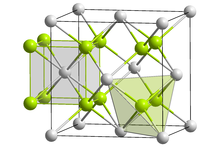 Crystal structure of lithium polonide
__ Li+ __ Po2- | |
| Names | |
|---|---|
| Preferred IUPAC name
Lithium polonide | |
| Identifiers | |
3D model (JSmol)
|
|
| |
| |
| Properties | |
| Li2Po | |
| Molar mass | 222.86 g/mol |
| Appearance | greyish[1] |
| Related compounds | |
Other anions
|
Lithium oxide Lithium sulfide Lithium selenide Lithium telluride |
Other cations
|
Polonium hydride Sodium polonide Potassium polonide |
Except where otherwise noted, data are given for materials in their standard state (at 25 °C [77 °F], 100 kPa).
| |
Lithium polonide is a chemical compound with the formula Li2Po. It is a polonide, a set of very chemically stable compounds of polonium.[2][3]
YouTube Encyclopedic
-
1/3Views:34 447578 0433 068 625
-
Writing Ionic Formulas - Basic Introduction
-
Lithium - The Lightest Metal on Earth
-
Get Lithium Metal From an Energizer Battery
Transcription
Production
Lithium polonide may be produced from a redox reaction between aqueous polonium hydride and lithium metal[2][3] or from an acid-base reaction of H2Po with strong lithium-containing bases:
- H2Po + 2 Li → Li2Po + H2
It may also be produced by heating lithium and polonium together at 300–400 °C.[1]
Crystal structure
Like sodium polonide, lithium polonide has the antifluorite structure.[2][3]
References
- ^ a b Bagnall, K. W. (1962). "The Chemistry of Polonium". Advances in Inorganic Chemistry and Radiochemistry. New York: Academic Press. pp. 197–230. ISBN 9780120236046. Retrieved June 17, 2012.
- ^ a b c Greenwood, Norman N.; Earnshaw, Alan (1984). Chemistry of the Elements. Oxford: Pergamon Press. p. 899. ISBN 978-0-08-022057-4.
- ^ a b c Moyer, Harvey V. (1956), "Chemical Properties of Polonium", in Moyer, Harvey V. (ed.), Polonium, Oak Ridge, Tenn.: United States Atomic Energy Commission, pp. 33–96, doi:10.2172/4367751, TID-5221.
